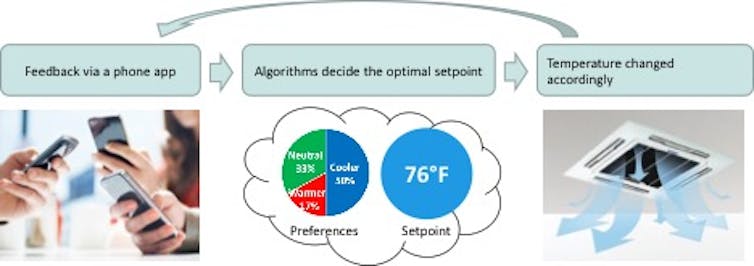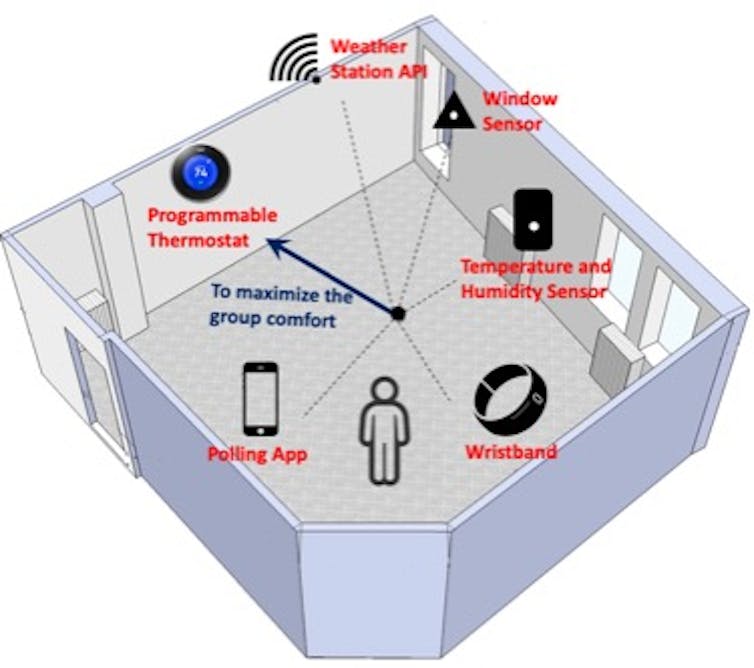Offices are too hot or too cold – is there a better way to control room temperature?
Everyone has a different ideal temperature at any given time. It could be more comfortable to monitor people's body temperatures and adjust heating and cooling in response.

In any office, home or other shared space, there’s almost always someone who’s too cold, someone who’s too hot – and someone who doesn’t know what the fuss around the thermostat is all about.
Most often, building owners and operators find out how their heating and cooling systems are doing by asking occupants if they’re comfortable or whether they want to be cooler or warmer. However, everyone has a different ideal temperature at any given time, based on all sorts of factors, including their age and gender, their physical activity level, what they’re wearing and even how much stress they’re feeling at the moment. This is a complex problem: For instance, people entering a cool room in the summer may initially feel comfortable but end up feeling too cold after a while.
Those human variables are considered static over time in the current industry guidelines for heating and cooling, which recommend a range of 68.5 to 75 degrees Fahrenheit in winter and 75 to 80.5 in summer. As a result, people often feel too hot or too cold, despite how much energy heating and cooling systems use.
More people would be more comfortable – improving their health and productivity – if furnaces and air conditioners could respond in real time to how building occupants were feeling, including how they change through the day. Our research group has been working on how to incorporate human feedback about room temperatures into heating and cooling systems. What we’re developing could help people feel more comfortable, and even let buildings use less energy.
Getting people’s feedback
Some researchers have proposed asking officemates to basically vote on what the temperature should be. Using a phone app or website, building occupants say whether they’re too hot or too cold, and what would make them more comfortable. An algorithm then analyzes the groups’ answer and calculates a temperature estimated to be most acceptable to most people.

However, that method has two significant limitations: To work best, it requires near-constant input from people who are supposed to be working – and still doesn’t factor in whether someone who is uncomfortable could help themselves by putting on or taking off a sweater. It also doesn’t take into account how people’s bodies experience temperature, which is closely tied to how cool or warm they prefer their environment to be.
Monitoring temperature remotely
In previous research, our group placed multiple temperature sensors around an office, and combined their data with information from wristbands that sensed occupants’ skin temperature and heart rates and apps that polled workers about how they felt. We found that adding the data about how people’s bodies were reacting made the algorithm more accurate at calculating the room temperature at which people occupying a given space would feel most comfortable.

Our current project, seeks to make things even easier and less intrusive for people, eliminating the wristbands and apps, and only using remote sensing of people’s skin temperature to measure how comfortable they are. We developed a method using regular cameras, thermal imaging and distance sensors to detect occupants’ presence in a space, focus on their faces and measure their skin temperature. From that data, our algorithm calculates whether – and how – to change the temperature in the room regardless of the number of occupants in the space. When we tested it in an office occupied by seven people, they complained less about feeling uncomfortably cold or warm.

This method is most effective in multi-occupancy spaces, like open-plan offices, meeting rooms and theaters. It can accommodate, and account for, differences in temperature between people in different areas of a room, whether they are standing or sitting or moving around. And it can adjust on the fly without requiring active human feedback. Our group will continue to explore this and other non-intrusive methods to help people feel more comfortable – and be healthier and more productive.
Carol Menassa receives funding from the National Science Foundation.
Da Li is funded by grants from the National Science Foundation to his advisor.
Vineet Kamat receives funding from the United States National Science Foundation. The work discussed in this article has been supported by the grant CBET #1804321.
Read These Next
The world risks forgetting one of humanity’s greatest triumphs as polio nears global eradication − 7
Polio may finally be defeated in the next 5 years. Will the world recognize what an extraordinary achievement…
Medieval peasants probably enjoyed their holiday festivities more than you do
The Middle Ages weren’t as dreary and desperate as you’d think, and peasants often had weeks of…
Autocracies in transition: In 2025, Cameroon and Tanzania rulers clung to power — but look more vuln
The countries, whose respective leaders recently won widely disputed elections, offer contrasting examples…





